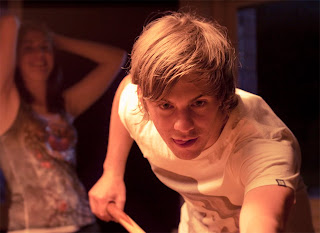
F/3.5, 1/50, ISO 1600, Curves Adjustment, Crop, Post Blur
Specifically applicable to my Canon 50D with Canon 50mm f/1.4 USM
DISCLAIMER: This is all based on my limited experiences. Further experiences may prove me entirely wrong about everything.
Keep ISO as low as possible. 640 is acceptable. 800 is pushing it. 1600 looks like your phone took the photo.
Keep Shutter over 25. Any slower hand-held WILL result in camera shake. 50+ is preferable.
Aperture can go wide, but focus is super tricky.
Group shots need a smaller aperture (f/4+) to get everyone's eyes in focus. 90% of the time I want to focus on the eyes, shooting open (f/1.4) results in focus so shallow that often only one eye is in focus.
Use zoom assist for focusing. I gotta learn to switch it on and off fast.
Watch highlights, expose for skin. Blowing out specular highlights is okay; blowing out skin tones is not.
Fire off 3-5 shots with each burst (in quick burst mode) . Flash Memory is expendable, the shot is not.
Watch framing in portrait shots. Choose what side of the camera is to be the top and bottom (holding the camera 90'CCW makes focusing difficult, but holding it 90'CW makes the camera shake during shutter release) .
Back off. Go wide and crop in post. I'm used to wide lenses, so the 50mm (80mm on an APS-C sensor) seems very long to me.
Find light. Candles, lamps, cigarettes. Direct, spilled or bounced. NEED IT.
Wrapping up, I think that my procedure for exposing should be adjusting:
- Aperture first because focusing is something I can theoretically control.
- Shutter second because I can only hold my hands steady to a point and I don't mind a bit of motion blur in the already moving subject (I'm used to the 1/50 shutter look from film and video).
- ISO lastly because I shouldn't have to adjust it much unless the lighting situation is really varied. If I'm in the same area I will probably set and forget it. If I can't get a decent exposure with the aperture and shutter I'll change the ISO.
Watching: Classic Albums - The Who - Who's Next
Reading: Coraline: The Visual Companion
Listening to: The Brian Setzer Orchestra - Wolfgang's Big Night Out

No comments:
Post a Comment